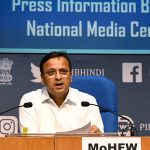On August 15, Prime Minister Narendra Modi announced plans to give every Indian citizen a unique health ID as part of the National Digital Health Mission (NDHM), which will digitise health records as well as provide a registry of doctors and health facilities. The decision has immense potential to change India’s health infrastructure, while also raising concerns over privacy and efficient implementation.
To begin with, the health ID will undoubtedly give a much-needed technological impetus to a sector that has long been found wanting, more so amid the ongoing Covid-19 pandemic. However, unlike Aadhar, the health ID isn’t mandatory and is only one of the components of the Mission, which the government reckons will go a long way in providing universal health coverage to over 1.3 billion people.
In his speech from the Red Fort, Modi had said: “The National Digital Health Mission is being launched today. This will bring a new revolution in India’s health sector and will help reduce problems in getting treatment with the help of technology. Every Indian will be given a health ID, which will work as each Indian’s health account.”
Since then, the NDHM has been rolled out on a pilot mode in six Union Territories. The NDHM comprises six areas, including health ID, DigiDoctor, health facility registry, personal health records, e-pharmacy, and telemedicine. Already, amid the Covid-19 outbreak, the government had pushed for the legalisation of telemedicine, which had largely stayed on the fringes until then. Under the new norms, registered medical practitioners could use all channels of communication, including voice, video, and text, for diagnosis and consultation.
Want to publish your own articles on DistilINFO Publications?
Send us an email, we will get in touch with you.
“Think of it as the UPI for the health care sector,” says Meena Ganesh, founder and MD of Portea Medical. “The public health sector has been in shambles, and the access to doctors is still tough. For the middle-class and the lower middle-class, any critical illness can entirely wipe them out. With technology and digital access across smaller locations, it can help bring health care to their houses at low cost.”
For now, the NDHM is to be implemented by the National Health Authority, the nodal authority for the Pradhan Mantri Jan Arogya Yojana. “The implementation of NDHM is expected to significantly improve the efficiency, effectiveness, and transparency of health service delivery overall,” a strategy document unveiled by the government says. “Patients will be able to securely store and access their medical records (such as prescriptions, diagnostic reports, and discharge summaries), and share them with health care providers to ensure appropriate treatment and follow-up. They will also have access to more accurate information on health facilities and service providers. Further, they will have the option to access health services remotely through teleconsultation and e-pharmacy. NDHM will empower individuals with accurate information to enable informed decision-making and increase accountability of health care providers.”
Gamechanger
Once rolled out nationwide, the programme has the potential to be a gamechanger. But much depends on implementation, and the laws surrounding it. “So far, all the attention had been on providing basic health care,” says Prashant Tandon, the co-founder and CEO at 1MG, a digital health care company that provides telemedicine and e-pharmacy services, among others. “Now, health care providers and companies will move into core innovation that will help improve the quality of the health care provided. All of that makes this exciting. It actually took a crisis of this scale to bring meaningful changes to the health sector.”
The health scheme will provide choice to individuals to access both public and private health services, according to the strategy plan, and ensure transparency in the pricing of services. For now, however, private companies are awaiting clarity on this front.
“This is perhaps the most disruptive action taken by the government in the health care sector, and is quite forward-looking,” says Dr Nandakumar Jairam, the chairman and CEO of Columbia Asia Hospitals. “It has created access to patient records without owning their records. That means there is no repository and related costs associated with it. It will provide a platform to contribute to the treatment and speed up the control management of non-communicable diseases such as diabetes and hypertension.”
With telemedicine also being brought within the ambit, the programme ensures that doctors will be able to provide direct access to remote areas across the country. That’s also perhaps why the NDHM is often being compared to the Unified Payments Interface (UPI), a platform that financial services companies use for transactions. Under the Mission, a user can, in the same way that they use Paytm or Google Pay, choose from several private health care providers and personalised offerings.
“It has a big role when it comes to disease management,” explains Ganesh of Portea. “If you look at rural India, ASHA (accredited social health activist) workers are the last mile when it comes to ensuring health care services. They often visit every month. In case of diseases such as diabetes and hypertension, it will become easy to monitor the health of the patient and provide remedial measures instead of responding to it at a critical stage, which can be an expensive affair. That means the scheme has a huge role in disease management.”
Meanwhile, it is also not just individuals who could emerge beneficiaries of the scheme. With large swathes of data being made available, the government too can form policies based on geographical, demographical, and risk-factor based monitoring of health.
“At the centre of this elaborate plan is electronic medical records,” says Vishal Bali, co-founder and chairman of Medwell Ventures and the Asia head of health care at TPG Growth, the global private equity firm. “The problem is that, even in the US, being the most advanced when it comes to digital health care, interoperability of electronic records remains a problem. India is in a unique position as we are starting out, and that means we can solve this and move ahead. But like always, we shouldn’t falter at the implementation stage.”
Critical to that is also the role of doctors, who will play a significant role in maintaining the electronic digital data. “But we often tend to ignore the massive demand-supply gap when it comes to talent. The growth path is powered by clinicians and we haven’t really been successful in creating good talent.”
India currently has 0.8 doctors per 1,000 patients, in comparison to over 2 per 1,000 in China and 2.6 in the US. The World Health Organization recommends one doctor to 1,000 patients. “There is no idea more powerful than this and the execution will require a differentiated approach,” adds Bali. “But, as with infrastructure, we shouldn’t falter particularly when it comes to the Centre and state. At the centre of digitisation will be district hospitals and that’s where the work has to start.”
Source: Forbes India








